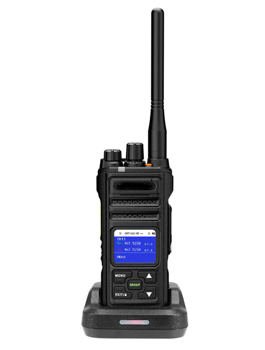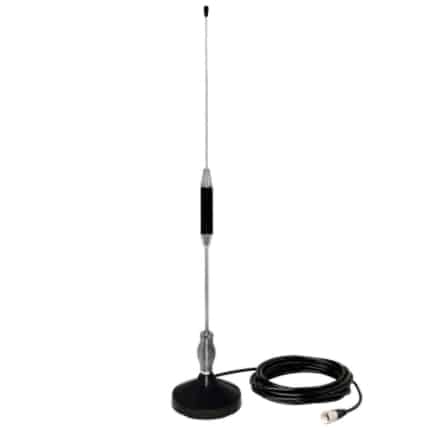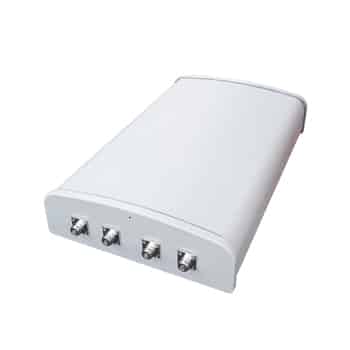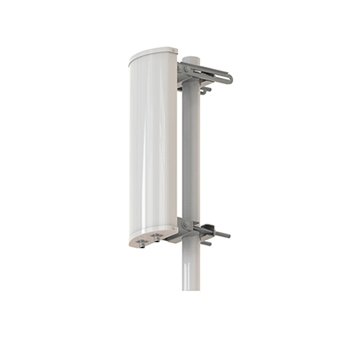
GMRS stands for General Mobile Radio Service, and this is typically used for short-range two-way communication. GMRS channels are for short-distance, two-way voice communication systems and some of the most common applications are when using hand-held radios, mobile radios, and repeater systems.
This article provides a detailed insight into GMRS, including the different channels available, the advantages and common use cases, license requirements for the operation of GMRS, etc. This article provides a comprehensive overview of GMRS frequencies and channels, key features, benefits and use cases, different equipment available, and much more.
Table of Contents
ToggleIntroduction to GMRS
GMRS is a land-mobile FM UHF radio service that provides two-way communication over short to medium distances. GMRS generally operates around 462 MHz and 467 MHz frequencies and over 22 channels divided as simplex and repeater channels. GMRS requires a license to operate. GMRS is generally more powerful than FRS (Family Radio Service) and is able to offer better range and better performance in various environments. GMRS is used for various applications, from outdoor activities like camping, events, and festivals to emergency situations.
Features of GMRS
GMRS as briefly discussed above is a service used in the UHF range of frequencies for two-way radio communication and requires users to have a license to use it. GMRS operates on frequency bands that the government specifically allocated for civilian use as is sometimes known as personal radio services. GMRS overlaps some of the frequency bands and channels with FRS and thus can communicate with each other. GMRS has more power than FRS. They share 22 channels and have 8 additional repeater channels that are unique and dedicated to GMRS. GMRS frequencies range between 462 MHz and 467 MHz and offer better range, coverage and signal quality than other technologies that are similar such as Citizens Band Radio Service (CBRS), the Family Radio Service (FRS) and the Multi-Use Radio Service (MURS). Users must obtain a license issued by the Federal Communications Commission to use GMRS and this license generally covers immediate family members, allowing the use of GMRS devices for personal and non-commercial purposes. GMRS devices also have the ability to use privacy codes that are used to encode any data that is transferred through the channel to minimize any security concerns or interferences from other users using the same channel for communication. GMRS devices are considered to be versatile as they can be used for a wide range of applications including many outdoor activities such as camping, hunting, family events, business gatherings etc. and they have a broad compatibility as they share certain frequency bands with the other technologies and hence can be used to communicate with devices operating in those technologies as well. This interoperability between other devices makes them a convenient and versatile choice for most use cases.
What is a GMRS Radio Commonly Used For?
GMRS backed devices are used in a wide range of applications for two-way communication over short to medium ranges. Some of the most common use cases are outdoor activities such as camping, hiking and hunting where regular mobile phone signals might not be readily available. GMRS devices are also convenient to use during events like fairs, festivals, theme parks, or in large venues for people to stay connected. They are also used among travelers to communicate between recreational vehicles, boats, motor homes, etc. which is important for navigation. GMRS devices are similarly useful in wildlife and wilderness related activities to communicate effectively without causing any disturbance to animals or the environment. GMRS devices are also used in industries like construction, to ensure reliable communication between workers, supervisors, and equipment operators and also in workplaces like warehouses, factories, farms, etc. where the employees will be spread out and located in a considerably large area. GMRS devices become extremely useful for communicating during emergencies and unexpected natural disaster situations when traditional communication systems might be disrupted and can be used to coordinate between disaster relief teams, search parties, etc.
- Kayaking
- Mountain biking
- Music festivals
- Trail riding
- Climbing
- Hiking
- Litter cleanup
- Geocaching
- Gold panning/prospecting
Licensing GMRS
Every individual GMRS-driven device needs to be licensed before operating in the GMRS frequencies. GMRS licenses are regulated and issued by the Federal Communications Commission (FCC) in the United States. Any individual operating a GMRS radio must have a valid GMRS license issued by the FCC, however, this license will cover the immediate family members which includes the spouse, children, parents, and grandparents. The license will allow users to use the GMRS devices for personal, non-commercial purposes and does not cover any business or commercial purpose. Typically, the license is issued for a period of 10 years after reviewing the application and collecting the license fee. After the license is issued by the FCC, users can use the devices anytime, but they must adhere to the FCC’s rules and regulations and must communicate only on approved frequencies, using approved equipment, and following recommended power limits.
Given below is a table that summarizes the GMRS frequencies and channels along with the allowed limits of maximum power and bandwidth.
| GMRS Simplex Channels and Frequencies | |||
| Channel | Frequency | Max Power | Bandwidth |
| 1 | 462.5625 | 5W | 25kHz* |
| 2 | 462.5875 | 5W | 25kHz* |
| 3 | 462.6125 | 5W | 25kHz* |
| 4 | 462.6375 | 5W | 25kHz* |
| 5 | 462.6625 | 5W | 25kHz* |
| 6 | 462.6875 | 5W | 25kHz* |
| 7 | 462.7125 | 5W | 25kHz* |
| 8 | 467.5625 | 0.5W | 12.5kHz |
| 9 | 467.5875 | 0.5W | 12.5kHz |
| 10 | 467.6125 | 0.5W | 12.5kHz |
| 11 | 467.6375 | 0.5W | 12.5kHz |
| 12 | 467.6625 | 0.5W | 12.5kHz |
| 13 | 467.6875 | 0.5W | 12.5kHz |
| 14 | 467.7125 | 0.5W | 12.5kHz |
| 15 | 462.5500 | 50W | 25kHz* |
| 16 | 462.5750 | 50W | 25kHz* |
| 17 | 462.6000 | 50W | 25kHz* |
| 18 | 462.6250 | 50W | 25kHz* |
| 19 | 462.6500 | 50W | 25kHz* |
| 20 | 462.6750 | 50W | 25kHz* |
| 21 | 462.7000 | 50W | 25kHz* |
| 22 | 462.7250 | 50W | 25kHz* |
| GMRS Repeater Channels and Frequencies | ||||
| Channel | RX Frequency | TX Frequency | Max Power | Bandwidth |
| RPT15 | 462.5500 | 467.5500 | 50W | 25kHz* |
| RPT16 | 462.5750 | 467.5750 | 50W | 25kHz* |
| RPT17 | 462.6000 | 467.6000 | 50W | 25kHz* |
| RPT18 | 462.6250 | 467.6250 | 50W | 25kHz* |
| RPT19 | 462.6500 | 467.6500 | 50W | 25kHz* |
| RPT20 | 462.6750 | 467.6750 | 50W | 25kHz* |
| PRT21 | 462.7000 | 467.7000 | 50W | 25kHz* |
| RPT22 | 462.7250 | 467.7250 | 50W | 25kHz* |
*FREQUENCY TABLE & NOTES FROM WIKIPEDIA*
Considering the above table that breaks down the GMRS frequencies into channels, one of the most noticeable factors is that although the frequency difference is small, there are three separate levels of maximum powers assigned for usage within the frequencies which are 5 W, 0.5 W, and 50 W. Based on the limits on how much power can be used to transmit the signal, the GMRS channels can be separated into three sections where channels 1-7 have a medium power and hence, best used for medium-range communications, channels 8-14 have low power and hence best used for short-range communications and channels 15-22 have the maximum power and hence is ideal for the long-range transmissions. Selecting which channel to use depends on the use case and purpose of the GMRS device. Also, in most cases, it is possible to adjust the power of a channel and it is generally recommended to use the minimal power required for the purpose.
Difference Between Simplex and Repeater Channels
As presented in the table, the GMRS frequencies are divided into 30 channels out of which 22 channels are shared with FRS and are known as the Simplex channels. The remaining 8 channels are known as repeater channels. Simplex channels are used for direct device to device communication without the use of a repeater. They generally operate in a single frequency and communicate in a single direction. Repeater channels, on the other hand, receive signals and then retransmit them to improve the range of communication. Devices that use the GMRS repeater channel are generally located in elevated positions to improve signal reception and transmission. Simplex channels are suitable for most of the common short range communication use cases while the repeater channels are better for long range communication applications. Choosing the right channel can make a huge difference and is vital for reliable and stable communication and to ensure a greater user experience.
Frequency Sharing with FRS
As discussed, GMRS and FRS share many frequencies, basically the first 22 channels. However, while GMRS requires a license to operate in those frequencies, FRS does not require any license to operate. This makes FRS devices more accessible for casual users but has to be under strict power limitations and interference. The key performance-wise difference between GMRS and FRS devices is that the GMRS devices are able to operate at higher power levels up to 50 W while FRS devices can reach a maximum power of 2 W for signal transmission. Hence, even in the shared frequency channels, GMRS devices can provide better range and better quality in communication. GMRS channels are compatible with FRS channels and hence allow interoperability and ensure communication between the two services. However, FRS devices cannot use detachable antennas, unlike GMRS radios. Besides the fact that GMRS can use higher power on most shared channels, GMRS also has exclusive access to 8 repeater channels. Based on the shared channels and their key differences in performance, their use cases can differ. GMRS is more commonly used for off-road trips, long-distance hiking, emergency communication systems, family outings, etc., while FRS is more suitable for short-range communication such as small group activities such as camping, local events, casual use among family and friends, etc. Understanding the differences between these two services will help to decide between the right service for the specific use case. While GMRS offers better power, range, and quality in communication, FRS provides more simplicity and accessibility, and by proper knowledge of GMRS and FRS it will be possible to make a well-informed decision.
Advantages of GMRS
GMRS has gained wide popularity due to its impressive features and its advantages. GMRS devices are able to transmit signals over a longer range than other unlicensed services like FRS and CB due to their high power output. Typically, they are able to reach up to 5 to 10 miles in open areas and even more than that when used with repeaters. Unlike FRS, GMRS can use repeaters which are devices that can receive and retransmit the signals further, thus, extending their range considerably. Also, the presence of multiple channels, over 22, provides more scope and bandwidth to establish communication with reliability. This makes them ideal to be used in situations like emergencies, outdoor activities, and community events. GMRS-driven devices are very flexible and versatile to use. They are equipped with many additional features, such as weather alerts, privacy codes etc. GMRS makes use of privacy codes such as the Continuous Tone-Coded Squelch System (CTCSS), which helps to minimize interference from other users on the same channel by filtering out unwanted signals. The devices can be configured to receive and transmit only from a specific tone. GMRS devices are extremely useful during emergencies and natural disasters as they can be equipped with NOAA weather alert capabilities that can provide real time weather updates, alerts, and warnings. Most of the GMRS devices and models are highly durable and weatherproof as they are built to be used in various outdoor activities. They are built to withstand even tough weather conditions with heavy rugged designs and structures as well as waterproofing.
Repeater Use in GMRS
As discussed previously in the article, GMRS repeater channels access the network of repeater towers and greatly increase the range of GMRS devices regardless of the wattage. These repeater towers typically act both as receivers and transmitters. They receive low-powered signals and then retransmit them with even greater power, thus providing coverage for much longer distances and without the degradation of the original signal. Repeaters enable users to communicate clearly and efficiently even when they are miles apart.
Types of GMRS Equipment
GMRS equipment is available in different configurations and models and some of the most commonly used ones are handheld radios, mobile units, and base stations. Handheld GMRS radios are compact, portable devices that are ideal for use cases where the user has to communicate while on travel or not in a stationary location. These handheld GMRS devices are usually weatherproof and have long battery life. Such devices are commonly used when hiking, camping, etc. GMRS devices are also available as mobile units in the market that are typically installed in vehicles. These devices are able to offer higher power and range making them ideal for outdoor large camping activities, road trips, wildlife adventures, etc. Another commonly available type of GMRS equipment is base stations. These are the stationary GMRS units that are typically designed for home or office use. They are able to provide robust and reliable communication with extended range.
When selecting GMRS equipment, there are several key factors to consider. It is better to select devices that offer high power output for extended range. Another major thing to look out for is their ability to withstand harsh weather conditions as most of the time these devices are used outdoors. It is also important to consider additional features like weather channels, privacy codes, and repeater capability for enhanced coverage and minimal interference.
Why GMRS Antenna Matters in a GMRS System
The antenna of a GMRS device plays a crucial role in deciding the performance level of the device just like in any other communication system. GMRS antennas are designed specifically to optimize the performance of GMRS systems. They are built to enhance the range and quality of the two-way communication system, whether it is used in a mobile, base, or repeater configuration. The ability to use specific detachable antennas provides them an edge over other similar technologies like FRS and CB as well where the antennas cannot typically be changed or modified.
Conclusion
GMRS is an excellent choice for reliable and effective communication in two-way communication systems over short to mid-range distances ranging from family outings, camping, hiking, and other outdoor activities to even emergency situations. GMRS operates in 30 channels out of which some are shared with other services like FRS and a few that can be used with repeaters for extended range. It is important to obtain the necessary FCC license to operate GMRS devices and choosing the right equipment and learning the fundamentals of their operation will enable the users to harness the optimal benefits of GMRS.








